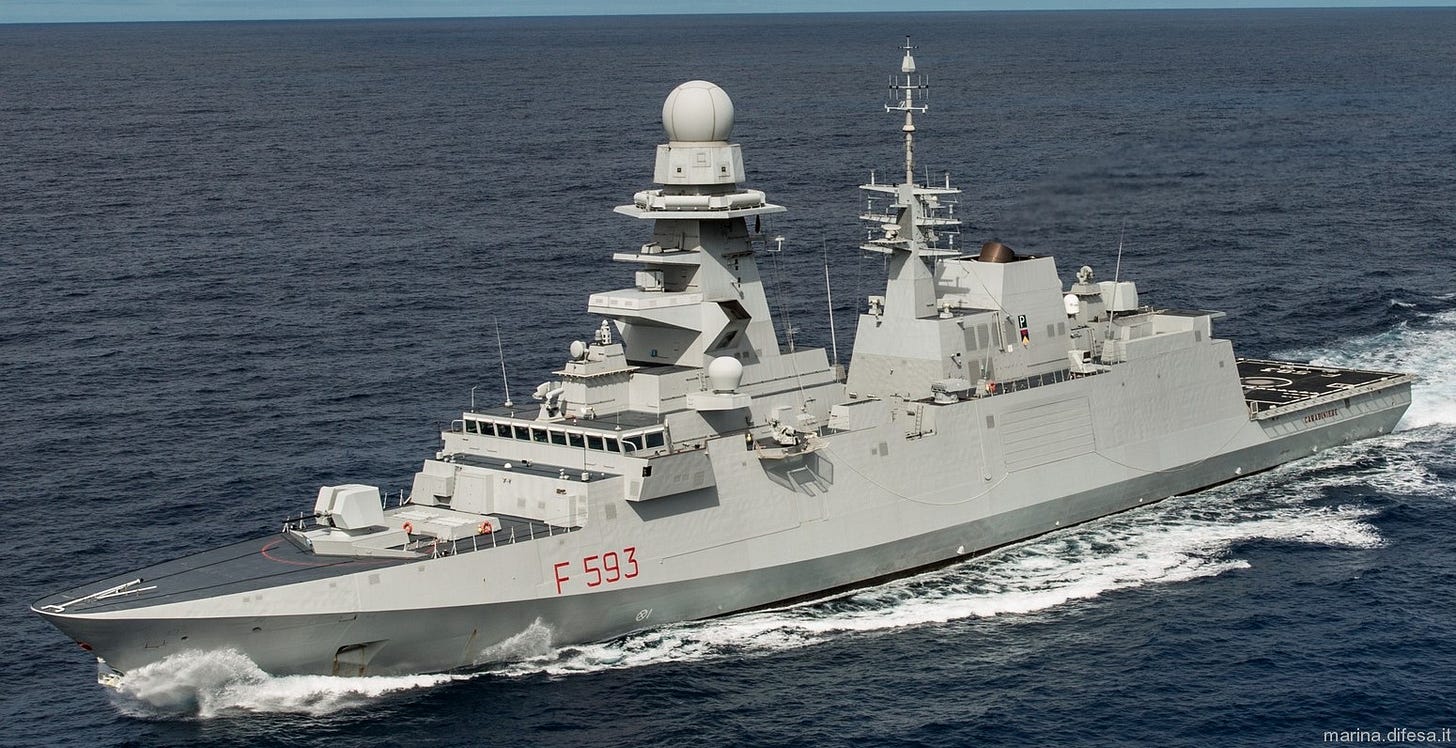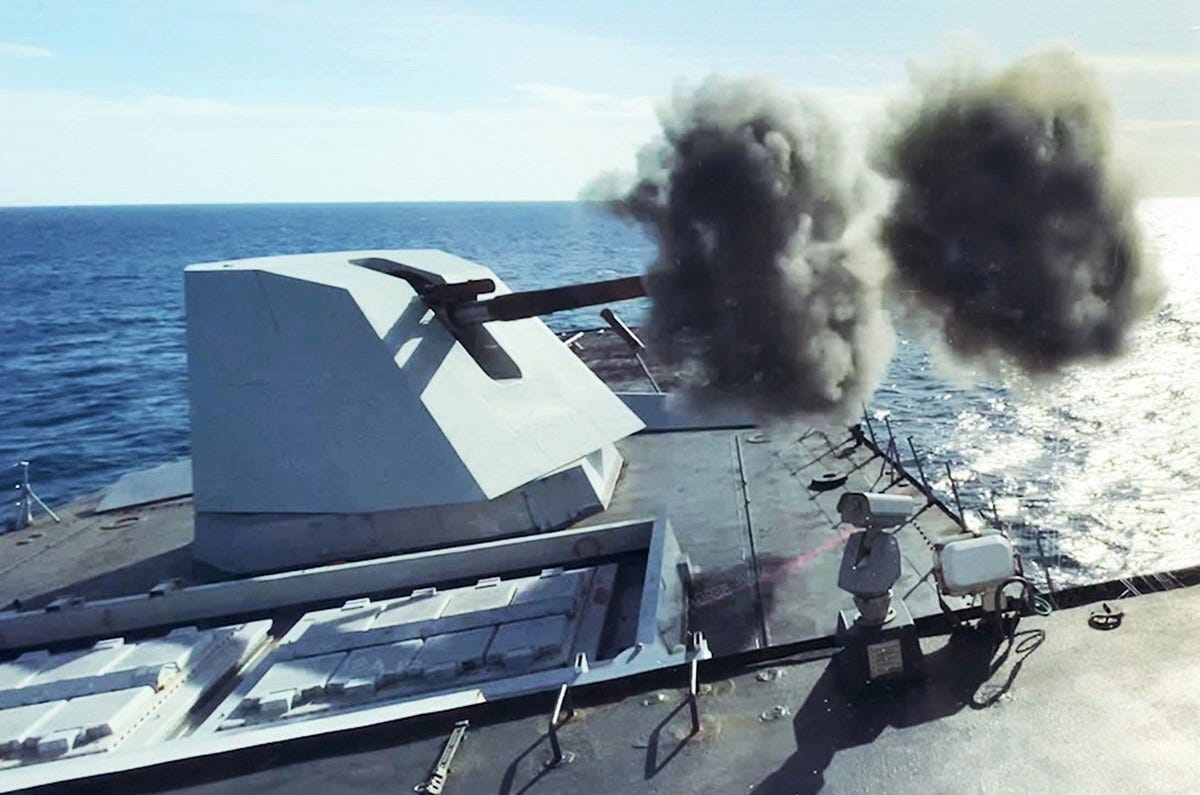Lessons from The Bergamini-Class Frigate: Italy’s Multi-Purpose Marvel
How to build multi-purpose ships quickly and efficiently.
Editor’s Note: Driven by my passion for ship design and construction, I aim to highlight some of my favorite contemporary ship designs, drawing from current news to spark accessible reading and lively discussion. The following op-ed is informed by a blend of articles, multimedia, and forums I follow, with sources reflected accordingly. All opinions shared are my own and do not reflect the views of anyone but myself.
Overview: The Dawn of Europe’s “Good Frigate Era”
The Carlo Bergamini-class frigate is a standout in modern naval design—a sleek, capable warship born from a joint venture between France and Italy under the FREMM (European Multi-Mission Frigate) program. While France has its Aquitaine-class variant (worthy of its own discussion), Italy’s Bergamini-class represents the Italian take on this collaborative effort, and it’s impressive. These frigates come in three distinct configurations—General Purpose (GP), Anti-Submarine Warfare (ASW), and a hybrid GP Enhanced version—each tailored to specific roles, from anti-ship and land-attack missions to submarine hunting. With eight ships already in service with the Italian Navy, two more under construction, and two exported to Egypt, the Bergamini-class is proving its worth in regards to efficient ship construction in an age of cost overruns and delayed timelines.
Configurations: A Frigate for Every Mission
The Bergamini-class shines in its versatility, offering three configurations to meet diverse naval demands. The General Purpose (GP) variant is a multi-role powerhouse, equipped for anti-ship and land-attack missions with eight Teseo Mark 2 anti-ship missiles (two quadruple launchers). The Anti-Submarine Warfare (ASW) version trades some of that firepower for specialized capability, carrying four ASW missiles—essentially torpedoes delivered by missile, parachuting into the water to hunt submarines. Finally, the GP Enhanced variant, featured in the two ships still under construction, blends the best of both worlds, combining GP’s surface attack prowess with ASW features. This adaptability makes the Bergamini-class a flexible asset, and Egypt’s acquisition of two GP variants underscores its export appeal.

Weapon Systems: Precision and Power
The Bergamini-class has a capable armament—given its role as a frigate—with its GP configuration showcasing a formidable arsenal. At the bow, a Leonardo 127mm lightweight naval gun delivers long-range firepower, followed by a 16-cell Sylver A50 vertical launch system (VLS) firing Aster 30 long-range surface-to-air missiles for air defense. Moving aft, twin 25mm remote-controlled weapon systems (one per side) handle close-in threats, while two quadruple Teseo Mark 2 launchers provide anti-ship punch. Decoy systems—including a SLAT torpedo decoy launcher and a Selex SCLAR-H chaff/flare launcher—enhance survivability against torpedoes and missiles. Above the aircraft hangar, a Leonardo 76mm Strales gun offers rapid-fire point defense. The ASW variant swaps the 127mm gun for a second 76mm and adjusts missile loads, but the core VLS remains consistent across all versions.

Power & Distance: Design and Performance
The Bergamini-class is powered by a CODLAG (Combined Diesel and Gas) propulsion system, featuring a GE LM2500 gas turbine, four diesel generators, and two controllable-pitch propellers, plus a retractable auxiliary propeller for redundancy. At 144 meters long and displacing 6,700 tons fully loaded, it achieves speeds up to 27 knots (likely 30 in a pinch) and boasts a 6,000-nautical-mile range at 15 knots—perfect for transoceanic patrols (to the Red Sea perhaps?). The hangar accommodates up to two helicopters, enhancing its reach and flexibility. With eight ships commissioned since 2013 and two more in progress, Fincantieri’s production line has been humming since the first keel was laid in 2008.
Sensors & Helicopters: Extending the Reach
The Bergamini-class frigate boasts an advanced sensor suite, including the Selex RAN 30X radar for long-range 2D detection, the high-fidelity Kronos multifunction AESA radar for multi-target tracking, an ESM/ECM suite with Selex SASS IRST for electronic and infrared surveillance, and a Thales Altesse CESM for communications interception. A second Selex NA 25X fire control radar supports the 76mm gun, while ASW and GP Enhanced variants feature a Thales low-frequency hull-mounted sonar for submarine detection, making the frigate a formidable floating command center. Complementing this, it can carry two helicopters—typically an NH90 with 5-hour endurance and an EH101 with 7-hour endurance and 540-nautical-mile range—equipped with 360° surface search radar, dipping sonar for ASW, and armaments like MU90 torpedoes or Marte Mark 2 missiles, enhancing its power projection and submarine-hunting capabilities.
Production Numbers: Why Bergamini-Class Frigates Outshine the U.S. Constellation-Class in Build Efficiency
The Bergamini-class benefits from a streamlined build process that the U.S. Constellation-class, also derived from the FREMM platform, struggles to match. Italy’s Fincantieri has delivered eight ships since 2013, with two more nearing completion, leveraging a mature design and a stable production line. The use of predominantly Italian-made systems—especially from Leonardo—reduces reliance on foreign supply chains, minimizing delays and costs. In contrast, the Constellation-class, adapted by Fincantieri Marinette Marine for the U.S. Navy, has ballooned in complexity. Reports indicate it shares only 15% commonality with the original FREMM due to extensive redesigns, driving a 40% cost overrun and a three-year delay for the lead ship (now expected in 2029). The Bergamini’s focused variants and domestic sourcing offer a leaner, more efficient build process than the Constellation’s ambitious overhaul.
Final Thoughts: Italy’s Good One
The Carlo Bergamini-class is a triumph of Italian ingenuity. By leaning heavily on homegrown technology from Leonardo and MBDA, Italy ensures self-sufficiency in wartime—a good decision for its assumed focus on Mediterannean protection. Combining ASW and GP roles into a single hull, especially in the GP Enhanced variant, maximizes flexibility without duplicating platforms. The 76mm Strales gun with Dart ammo is a game-changer, offering pinpoint ballistic defense that outclasses traditional CIWS systems. Looking ahead, the FREMM-EVO configuration promises even more innovation—stay tuned for that story. With eight ships in service, two on the way, and a design that balances capability and efficiency, Italy has crafted a frigate that’s both a national asset and a global contender.




